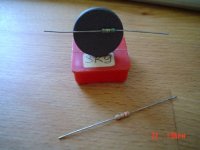I tried that and they didn't make any noise. Even when I put them into a nice, big pile and cupped my ear near it, they were absolutely silent.
Roushon, you might consider sacrificing a few; break off some of the conformal coating and take a look at what the resistor element looks like.
Roushon, you might consider sacrificing a few; break off some of the conformal coating and take a look at what the resistor element looks like.
details
the following are some details of the resistors. these are exactly what I read on the resistors.
1. 5 colour bands
2. 6 colour bands
3. JV-8K2, single yellow band
4. 1X-22R, single yellow band
5. 4 colour bands
6. FAC-1K1, single blue band
7. GWC-10K, single blue band
8. GXC-48R7, single blue band
9. GAC-56K2, single blue band
10. GU-150K, no colour band
11. GXC-3K83, single blue band
i do not have a digi-cam. so i am not able to show the pictures.
the following are some details of the resistors. these are exactly what I read on the resistors.
1. 5 colour bands
2. 6 colour bands
3. JV-8K2, single yellow band
4. 1X-22R, single yellow band
5. 4 colour bands
6. FAC-1K1, single blue band
7. GWC-10K, single blue band
8. GXC-48R7, single blue band
9. GAC-56K2, single blue band
10. GU-150K, no colour band
11. GXC-3K83, single blue band
i do not have a digi-cam. so i am not able to show the pictures.
JensRasmussen said:Carbon types are often 5% with 3 colour rings with one gold (5%)
Metal film types are often 1% and have more rings than the carbon types.
Try posting a picture of them, maybe we can sort it out this way
\Jens
i guess that the resistors 1,2,6,8,9,11 above are metal film.
The colour of the body is no indication at all. Metal flim can also be beige.Mr Evil said:Quite often metal films are blue and carbon films are beige.
Nothing external is any certain indication - both the body colour and the tolerance can be anything for either type, but usually they follow a pattern.peranders said:
The colour of the body is no indication at all. Metal flim can also be beige.
All very amusing.
Ever considered that metal is magnetic, carbon is not.
The body of a metalfilm sticks to a magnet, the leads generally do not as most leads are tinned copper.
Even MOX metaloxide bodies stick to a magnet.
None of the Vitrohm, Amroh, or Allan Bradley's carbon composites i have do
Ever considered that metal is magnetic, carbon is not.
The body of a metalfilm sticks to a magnet, the leads generally do not as most leads are tinned copper.
Even MOX metaloxide bodies stick to a magnet.
None of the Vitrohm, Amroh, or Allan Bradley's carbon composites i have do
Attachments
I don't want to be the skunk at the picnic, but...
Nichrome is not ferromagnetic.
If it were, the film is too thin to have any significant attraction to a magnet.
What the magnet is attracting is the ferromagnetic end caps which make contact with the resistive film/ceramic substrate.
Nichrome is not ferromagnetic.
If it were, the film is too thin to have any significant attraction to a magnet.
What the magnet is attracting is the ferromagnetic end caps which make contact with the resistive film/ceramic substrate.
True, nickel-chrome is not ferromagnetic.
Neither is a metaloxide layer, nor a carbon resistance track, a ceramic body, tinned copper or alloy leads.
The carbon composition resistors do not have end caps.
All of the carbon film resistors i have do not seem to have nickel-ferro end caps.
I know Beyschlag(Vishay BC / Philips BC) makes/made 2% accurate carbon films that look almost identical to the metal films they produce.
One way of finding out could be to check the TK value.
Regular low power metal films have a TK of 50, carbon films are in the order of TK = 200.
Yageo MF series have a TK of 25.
A reason for not using carbon films.
Any one of you have an idea how to check the power rating of a resistor, 1/4W, 0.4W, 1/2W, 0.6W, without having to destroy it ?
Neither is a metaloxide layer, nor a carbon resistance track, a ceramic body, tinned copper or alloy leads.
The carbon composition resistors do not have end caps.
All of the carbon film resistors i have do not seem to have nickel-ferro end caps.
I know Beyschlag(Vishay BC / Philips BC) makes/made 2% accurate carbon films that look almost identical to the metal films they produce.
One way of finding out could be to check the TK value.
Regular low power metal films have a TK of 50, carbon films are in the order of TK = 200.
Yageo MF series have a TK of 25.
A reason for not using carbon films.
Any one of you have an idea how to check the power rating of a resistor, 1/4W, 0.4W, 1/2W, 0.6W, without having to destroy it ?
SY-master,
you are right that it is far easier to just open up a couple.
i was merely wondering if there is a neat way of measuring the temperature of a resistor under load.
(i only buy resistors with a datasheet)
0.4 watt Yageo's are half the size of a 0.4 watt Beyschlag Components metal film resistor.
you are right that it is far easier to just open up a couple.
i was merely wondering if there is a neat way of measuring the temperature of a resistor under load.
(i only buy resistors with a datasheet)
0.4 watt Yageo's are half the size of a 0.4 watt Beyschlag Components metal film resistor.
- Status
- This old topic is closed. If you want to reopen this topic, contact a moderator using the "Report Post" button.
- Home
- Design & Build
- Parts
- metal film or carbon film?

